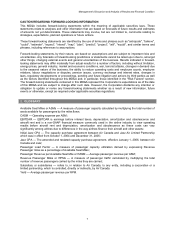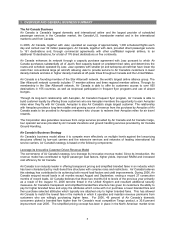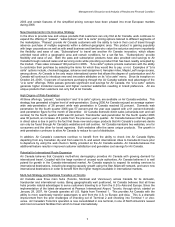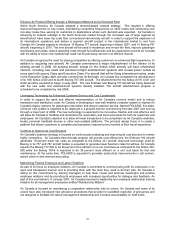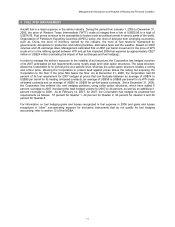Air Canada 2006 Annual Report Download - page 17
Download and view the complete annual report
Please find page 17 of the 2006 Air Canada annual report below. You can navigate through the pages in the report by either clicking on the pages listed below, or by using the keyword search tool below to find specific information within the annual report.
7.1 Summary of Air Canada Services Segment Results
The Air Canada Services segment reported an operating loss of $5 million in Quarter 4 2006, an improvement
of $86 million from the operating loss of $91 million recorded in Quarter 4 2005. EBITDAR increased $100
million over Quarter 4 2005.
Passenger Revenues
System passenger revenues in Quarter 4 2006 increased $122 million or 6 percent over Quarter 4 2005,
reflecting system traffic and yield improvements due to stronger market demand. The system yield
improvement of 1 percent in Quarter 4 2006 over the same period in 2005 was principally due to fuel-related
fare increases and increased fuel surcharges to offset higher fuel costs and, to a lesser extent, a higher average
business class fare. The yield increase was partly offset by the negative effect of a stronger Canadian dollar on
international, US transborder and domestic revenues. In Quarter 4 2006, traffic grew 5 percent on a capacity
increase of 4 percent over Quarter 4 2005, resulting in a passenger load factor increase of 1.1 percentage
points. RASM increased 2 percent compared to Quarter 4 2005 due to both the improvement in system
passenger load factor and the growth in yield.
The table below describes quarter-over quarter percentage changes in passenger revenues, capacity, traffic,
passenger load factor, yield and RASM.
Quarter 4 2006 Passenger Capacity Traffic Passenger
versus Revenue (ASMs) (RPMs) Load Factor Yield RASM
Quarter 4 2005 % Change % Change % Change pp Change % Change % Change
Canada 6 4 6 1.7 -
2
US transborder 10 11 15 2.0 (4) (1)
Atlantic 4 2 2 - 2
2
Pacific 1 - - 0.1 1
1
Other 6 1 5 3.0 1
5
System 6 4 5 1.1 1
2
Domestic passenger revenues increased $54 million or 6 percent in Quarter 4 2006 compared to Quarter 4
2005 due to traffic growth. Yield was essentially unchanged from the same period in 2005. Traffic grew 6
percent on a capacity increase of 4 percent resulting in a passenger load factor improvement of 1.7 percentage
points. Capacity increases were largely on transcontinental services. The suspension of Canjet’s scheduled
domestic operations in September 2006 also had a favourable impact on traffic in Quarter 4 2006. Domestic
RASM increased 2 percent compared to Quarter 4 2005 due to the improvement in domestic passenger load
factor.
US transborder passenger revenues rose $41 million or 10 percent in Quarter 4 2006 compared to the
corresponding period in 2005 due to an increase in traffic, the result of more capacity, a stronger market
demand and additional fuel-related fare increases to offset higher fuel costs. Yield decreased 4 percent in
Quarter 4 2006, reflecting a growth over 2005 in longer-haul flying to key leisure destinations. Long-haul flights
generally have a lower yield per revenue passenger mile than short-haul flights. When measured on a per mile
basis, the average fare paid on long-haul flights is relatively lower than on short-haul flights. At the same time,
since the costs of ground handling, take-off and landing are similar for both short and long-haul flights, unit
costs per ASM are normally lower for long-haul flights due to distance flown. The growth in passenger traffic of
15 percent in Quarter 4 2006 was largely a result of increased capacity on routes to Las Vegas, San Francisco
and Los Angeles and the addition of the Toronto-San Diego route in June 2006. US transborder RASM
decreased 1 percent over Quarter 4 2005 as a 2.0 percentage point improvement in passenger load factor was
more than offset by the decline in yield.
Atlantic passenger revenues increased $15 million or 4 percent in Quarter 4 2006 compared to the
corresponding period in 2005 due equally to yield improvement and traffic growth. Yield improved 2 percent
over the corresponding period in 2005 largely due to increased fuel surcharges to offset higher fuel costs.
Traffic growth was essentially in line with capacity growth resulting in a passenger load factor unchanged from
the same period in 2005. Atlantic RASM increased 2 percent due to the yield improvement.
17
Management's Discussion and Analysis of Results and Financial Condition


